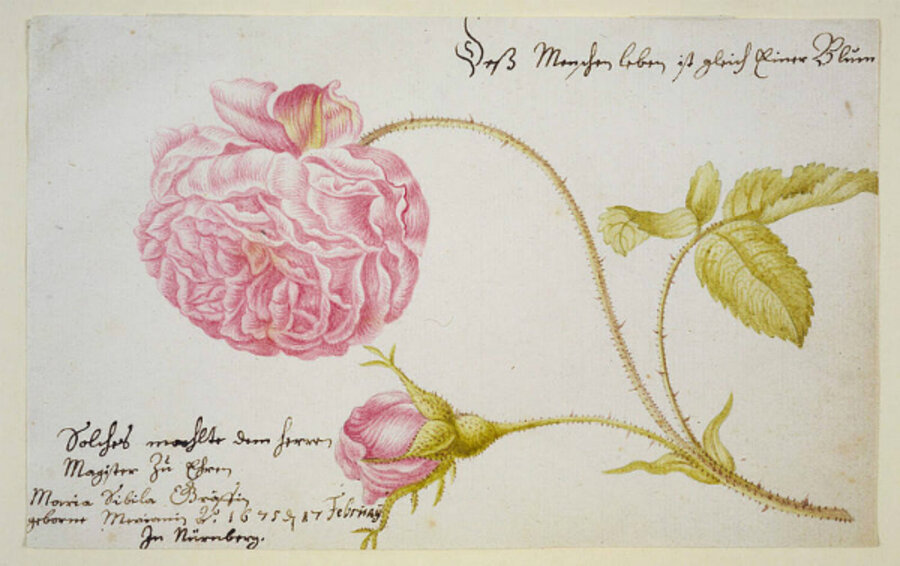Maria Sibylla Merian: Inspired her love of nature and art in her daughters
Loading...
The life of Maria Sibylla Merian, a 17th century German-born naturalist, entomologist, botanical illustrator, and divorced mother of two, paints a vivid picture for today’s parents on how to get kids into science using art. Ms. Merian, the subject of today’s Google Doodle, makes the process of engaging kids in science as simple as stopping to sketch the roses, and the aphids as well.
Today we call involving children in science via art a STEAM (Science Technology Engineering Art and Math) program. Merian was probably the very first STEAM-powered parent and others in her field today still emulate her parenting as well as artistic and scientific techniques.
“What made her work unique and important is that she not only illustrated the plants, but the insects as well,” says Wendy Hollender, who once headed up the New York Botanical Gardens’ Botanical Art Program and still teaches there. “Technically her [Merian’s] work was beautiful, but more important, she was really the first to include the insects and their relationship to the plants.”
Born April 2, 1647 in Frankfurt to a family of Swiss heritage, she was encouraged by her stepfather to take up the genteel art of painting. However, in 1660 she began to paint images of insects and plants from specimens she had captured. She kept specimens and studied their life cycles becoming one of the first archivists of the natural world. She did not quietly sit and paint pretty pictures as was expected of a woman in her era, but rather turned painting into a passion that paid the bills and served to educate her and her daughters.
After getting married and later divorced from Johann Andreas Graff, according to the J. Paul Getty Museum website, Merian continued to paint and teach painting. The Getty site states, “By 1686 Merian had left her husband and moved with her two daughters and elderly mother to a religious community north of Amsterdam, The Netherlands.”
As a mother, Merian brought her daughters Johanna Helena and Dorothea Maria into science via art, taking them out to her garden to collect specimens for study and as subjects for their art. Eventually their collective work was displayed at The Getty under the heading, “Maria Sibylla Merian & Daughters: Women of Art and Science.”
“Enterprising and adventurous, these women raised the artistic standards of natural history illustration and helped transform the field of entomology, the study of insects,” says the Getty website.
I love the fact that this woman back in the 17th century altered the image of women who fainted at the sight of a spider, redrew the boundaries for her children, and continues to inspire moms to do the same things with kids today.
Years ago, my mother-in-law, an artist and fan of Merian’s work, gave me the book “Roots, Shoots, Buckets and Boots,” by Sharon Lovejoy to encourage me to share my passion for gardening and botany with my boys. She included sketch pads and charcoal pencils with the gift.
Our perennial family favorite is to grow moonflowers and on summer nights to draw the blooms and, more importantly, the hummingbird-size moths that come out to feed on the nectar in the moonlight.
Hollender, recalls her own uphill battle as a mom trying to replicate Merian’s parenting success by trying to get her son and daughter, now in their late 20s, interested in botanical art. “I took them out on nature hikes, collecting flowers, and we all drew them afterwards," Hollander recalls. Now her daughter, Abby Goldfarb, teaches gardening and farming in an elementary school in New Mexico in a program funded by Americorps. Her son Jesse Goldfarb works for One Acre Fund in Rwanda.
Her parenting achievements, Hollender says, had roots in her role model, Maria Sibylla Merian. “In the end everything we did together actually did get them into careers in science, art, and botany in one form or another,” Hollender adds.
Despite the advent of high resolution photography, the skill of the botanical artist is in high demand, according to Hollender who just surpassed her Kickstarter goal of $25,000 to put out a volume on foraging and feasting: a field guide to natural food, with a final sum raised of $115,026.
Hollender says the details Merian pioneered in her work, like detailing how a leaf attached to its stem, became standards relied upon by those trying to correctly identify plants.
“What that told us was that when people need to identify a plant, they would much rather turn to a detailed and architecturally correct drawing than a photograph,” Hollender explained.
What the story of Merian and her daughters tells me is that with April showers come May flowers and all the bloom-seeking bugs that can bring modern parents back in time to an old school way of connecting our kids to a STEAMy future.






